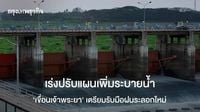Thailand is grappling with a dual crisis as persistent heavy rains, triggered by the powerful tropical storm Bualoi, have led to widespread flooding and landslides across nine provinces, while public health officials report a steady rise in monkeypox cases. The twin emergencies have tested the resilience of the country’s infrastructure and emergency response systems, prompting round-the-clock monitoring and urgent government interventions.
According to the Department of Highways’ latest situation report, published on September 30, 2025, severe flooding and landslides have rendered major highways impassable at six critical locations in Surin, Nakhon Ratchasima, Phitsanulok, and Uttaradit provinces. In total, 17 routes across 23 sites in nine provinces—including Surin, Nakhon Ratchasima, Chaiyaphum, Roi Et, Nong Bua Lamphu, Udon Thani, Chiang Mai, Phitsanulok, and Uttaradit—have been affected by floodwaters, with traffic through six of these points completely halted.
In Surin, the main route between Khok Sai and Puang Tuek is underwater, forcing drivers to detour via alternate highways 2283 and 2328. Nakhon Ratchasima faces a similar predicament, with the route between Khong and Non Thai submerged under 35 centimeters of water, and local authorities redirecting traffic through village roads. Phitsanulok and Uttaradit have been hit especially hard, with both provinces experiencing not only flooding but also landslides. In Phitsanulok’s Chat Trakan district, water levels on one highway have reached an astonishing 250 centimeters, while landslides have blocked other key routes. Uttaradit’s Thapla and Thong Saen Khan districts are also dealing with both high water and mudslides, complicating rescue and relief operations.
To mitigate the impact and ensure public safety, the Department of Highways has deployed teams to assist stranded motorists, provide traffic guidance, and monitor the evolving situation 24 hours a day. Citizens are urged to exercise caution, heed warning signs, and consult real-time updates via the department’s toll-free hotline (1586) or the Health Data Management System (HDMS) website. These resources are being constantly updated to reflect the latest road conditions and emergency measures.
The flooding crisis comes as the National Water Resources Office (NWRO) scrambles to manage dangerously high water levels at two of the country’s largest dams. Deputy Secretary-General Paitoon Kaengkanchang chaired an emergency meeting on September 30 to coordinate the national response. The meeting brought together experts and representatives from key agencies to assess the fallout from Bualoi, which has unleashed relentless downpours across the northern and northeastern river basins.
In just 24 hours, rainfall in the Nan River basin at Nam Pat and Thong Saen Khan districts of Uttaradit exceeded 300 millimeters, while Pong district in Phayao saw more than 170 millimeters. These deluges have triggered flash floods and torrents of runoff, inundating communities and farmland. Meteorological forecasts warn that a low-pressure system over the Philippines could bring further heavy rains to northern and northeastern Thailand around October 5, compounding the crisis.
The NWRO’s immediate strategy is threefold. First, the discharge rates at Sirikit and Bhumibol dams will be maintained at 15 million cubic meters per day for the next two to three days to avoid overwhelming downstream communities, especially in Nan River areas already facing rising water. However, with inflows continuing and reservoir levels nearing capacity, authorities are prepared to adjust outflows as needed to prevent overflow.
Second, the Chao Phraya Dam’s release rate is being increased from 2,300 to 2,400 cubic meters per second. This move is designed to prevent upstream water levels from exceeding 17.5 meters above mean sea level, which could threaten the dam’s structural integrity. Officials will closely monitor actual rainfall against forecasts and adjust the release schedule to minimize downstream flooding.
Third, water is being diverted into low-lying fields in the Chao Phraya basin where rice harvesting has been completed and local residents have been consulted. Special efforts are underway to drain excess water from heavily flooded areas like Bang Rakam, aiming to allow residents to return home and resume their livelihoods as soon as possible.
Despite the scale of the flooding, Deputy Secretary-General Paitoon reaffirmed the government’s commitment to preventing a repeat of the catastrophic 2011 floods. He emphasized that, while this year’s rainy season has been marked by the indirect effects of five tropical storms—numbers comparable to 2011—the authorities are confident that improved coordination and infrastructure will avert a similar disaster. Prime Minister Anutin Charnvirakul and Deputy Prime Minister Sophon Sarum have ordered all relevant agencies to provide comprehensive assistance to affected communities.
“After the heavy rains from this low-pressure system pass, the situation will gradually improve,” Paitoon stated, as reported by Bangkok Biz News. “The NWRO, together with all relevant agencies, will expedite the drainage of floodwaters to help people return to normal life as quickly as possible.”
While the nation’s attention is riveted on the flooding, the Department of Disease Control has reported an uptick in monkeypox cases. On September 30, 2025, health officials confirmed six new cases, bringing the total number of confirmed monkeypox infections in Thailand to 30 since the outbreak began. The department is keeping a close watch on 1,586 individuals who had close contact with confirmed cases, using the HDMS for real-time case tracking and management.
With concerns mounting, the Department of Disease Control has announced a press conference scheduled for October 24, 2025, to provide a comprehensive update on the monkeypox situation. The agency is also investigating 170 suspected cases and monitoring approximately 300 additional close contacts, underscoring the seriousness of the public health threat amid the ongoing natural disaster.
Officials are urging the public to remain vigilant, follow health and safety guidelines, and seek information from official sources. The convergence of these two crises—widespread flooding and a growing monkeypox outbreak—has placed extraordinary demands on Thailand’s emergency management systems. Yet, through coordinated action and transparent communication, authorities are working to minimize harm and restore stability.
As Thailand braces for another wave of rainfall and continues to battle the spread of monkeypox, the coming weeks will test the nation’s capacity for resilience and adaptation. With government agencies mobilized and communities pulling together, there is cautious optimism that, with time and effort, recovery will follow.

